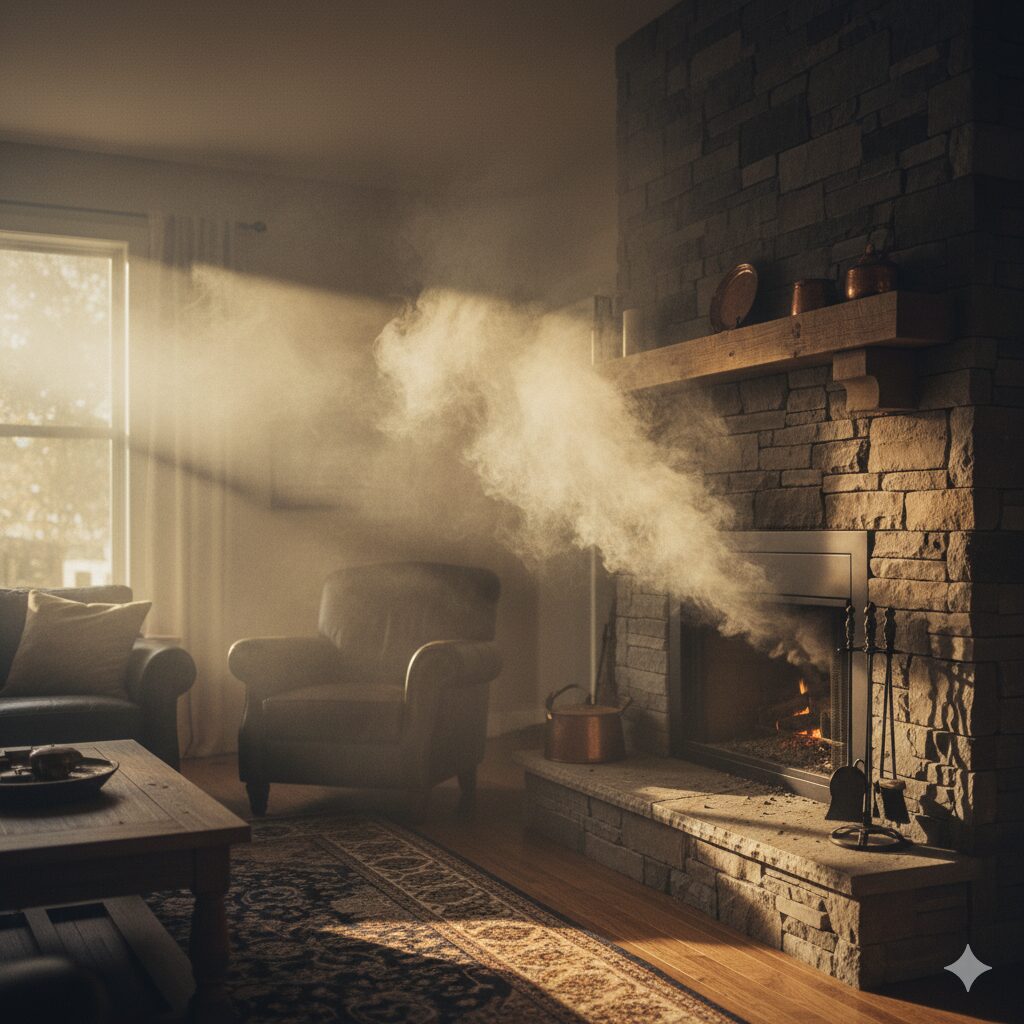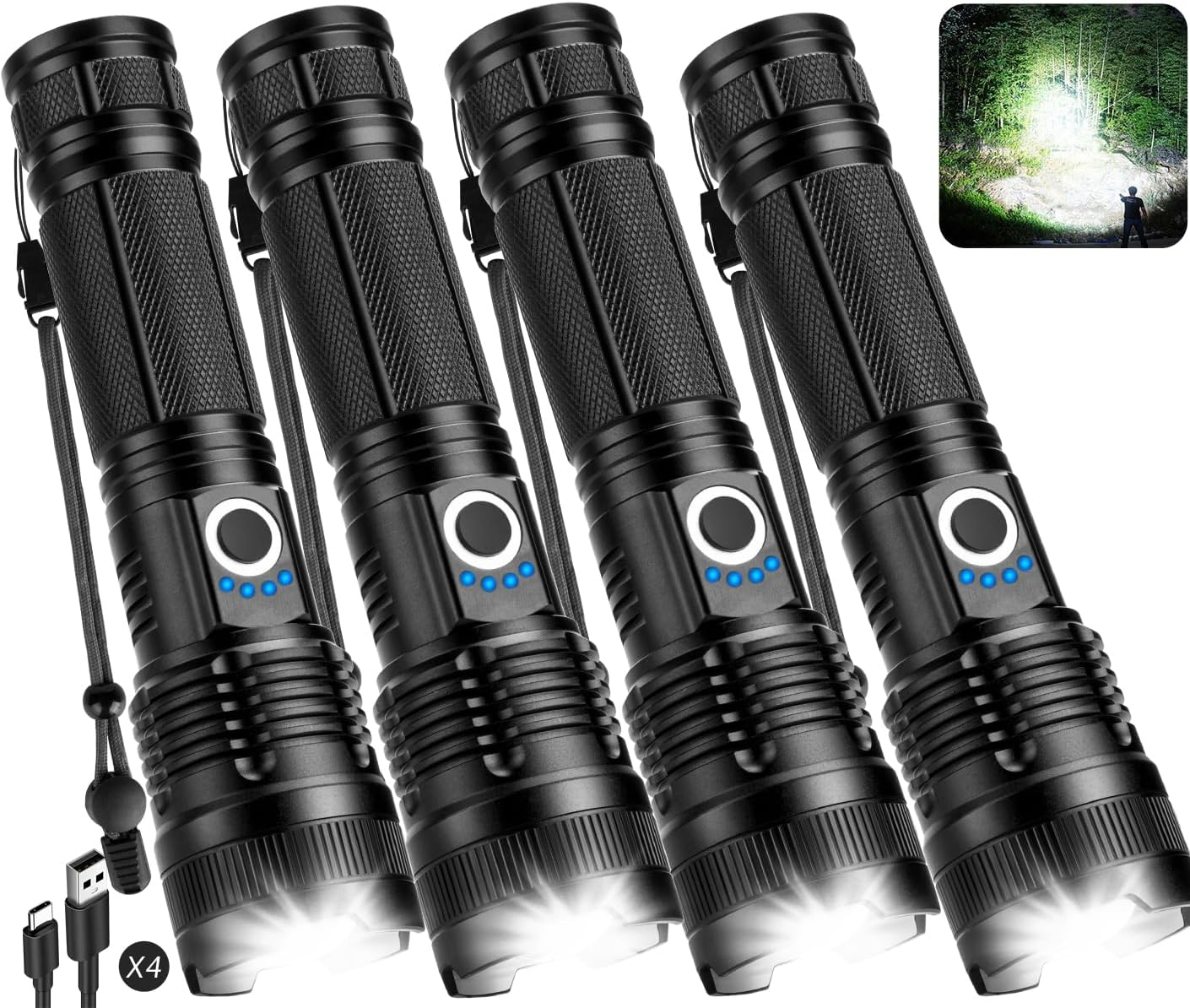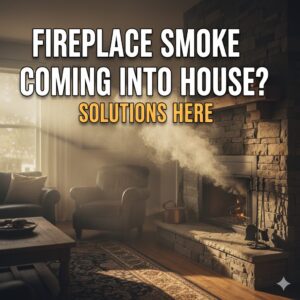Fireplace Smoke Coming Into House? A Step-by-Step Expert Guide to Find and Fix the Problem

There’s a romantic image we all have of a fireplace: cozy warmth, a crackling fire, and a relaxing ambiance. But when that idyllic scene is shattered by billows of thick, acrid smoke pouring into your living room, it’s more than just a nuisance—it’s frustrating, messy, and downright dangerous. A smoky fireplace is a clear sign that something is wrong with how your fireplace system is functioning, and ignoring it is not an option.
Fireplace smoke contains fine particulate matter, carbon monoxide, and other harmful compounds that you and your family should not be breathing. The good news is that in almost every case, a smoky fireplace is a solvable problem. The issue is rarely the fireplace itself but rather the physics of airflow and the condition of your chimney. It’s all about the “draft”—the upward flow of air that pulls smoke and gases out of your home.
This guide is your comprehensive, step-by-step diagnostic tool. We will walk you through the troubleshooting process exactly like a professional chimney sweep would, starting with the simplest user errors and moving toward more complex issues. By following these steps, you can identify the root cause of your smoke problem and learn how to fix it for good.
A Certified Chimney Sweep’s Safety Warning
As a CSIA (Chimney Safety Institute of America) Certified Chimney Sweep, I need to be blunt: A smoky fireplace is a dangerous fireplace. The smoke you see is an inconvenience, but the odorless, colorless carbon monoxide (CO) mixed with it can be deadly. If you have smoke coming into your house, your first step should be to extinguish the fire safely and ventilate the area. Your second step is to install and test carbon monoxide detectors. This guide will help you diagnose the issue, but for your family’s safety, never operate a fireplace that is not drafting correctly. When in doubt, call a professional from the list of best chimney services in your area.
First Things First: Quick Checks for Common User Errors
Before you start worrying about expensive repairs, let’s rule out the most common and easily fixable mistakes. A surprising number of smoke problems are caused by one of the following simple issues.
1. Is Your Damper Fully Open?
This may sound obvious, but it’s the number one cause of a smoky fireplace. The damper is a metal plate inside the chimney’s throat, just above the firebox, that is used to seal the chimney when not in use. If it’s closed or only partially open, the smoke has nowhere to go but back into your room.
- How to Check: Take a flashlight and look up into the throat of your (unlit!) fireplace. You should see a handle or a knob. Operate it and look for the metal plate. You need to see a clear, unobstructed path going straight up.
- Types of Dampers: Some are “poker” or “rotary” style inside the firebox, while others (“top-sealing” dampers) are operated by a chain hanging down the side of the flue. Make sure you know which type you have and that it’s opening completely.

Essential Diagnostic Tool: High-Lumen LED Flashlight
You can’t fix what you can’t see. A powerful flashlight is your best friend for fireplace troubleshooting. It’s essential for getting a clear view of your damper, looking up the flue for obvious blockages like a bird’s nest, and inspecting the firebox for cracks. Don’t rely on your phone’s light; get a dedicated, bright flashlight.
Check Price on Amazon2. Are You “Priming the Flue”? The Cold Air Plug
This is a huge issue, especially for chimneys on an exterior wall of the house in cold climates. Overnight, a column of heavy, cold air can settle in your chimney. When you light a fire, the hot, buoyant smoke isn’t strong enough to push this “cold air plug” out of the way, so it spills back into the room.
- The Solution (Priming): Before you light the logs, you need to warm up the flue to break the plug and establish a draft. The easiest way is to roll up a piece of newspaper, light one end, and hold it up in the throat of the chimney past the damper for a minute or two. You will literally see the smoke from the newspaper start to get pulled upwards. Once that happens, you have successfully established a draft and can safely light your fire.
3. Is Your Firewood Properly Seasoned?
Burning wet or “green” wood is a recipe for a smoky disaster. Well-seasoned wood should have a moisture content below 20%. Wet wood does two bad things:
- It Smolders: The fire wastes its energy boiling off water instead of burning cleanly. This low-temperature combustion creates an enormous amount of thick, heavy smoke.
- It Doesn’t Produce Enough Heat: The smoke isn’t hot enough to rise quickly and establish a strong draft, allowing it to linger and spill out of the fireplace opening.
If your fire is hissing and sizzling, your wood is likely too wet. To learn how to identify and source the right fuel, consult this guide on the best firewood for your fireplace.

Stop Guessing, Start Measuring: Wood Moisture Meter
This simple tool is the only way to know for sure if your wood is ready to burn. Don’t rely on appearance or how long it’s been stacked. Split a piece of wood and press the prongs into the freshly exposed face. If the reading is over 20%, the wood will cause smoke problems and create dangerous creosote. This is a must-have for any serious wood-burner.
Check Price on AmazonThe Most Common Culprit: A Blocked or Dirty Chimney
If you’ve ruled out user error, the next and most likely cause is an obstruction in the chimney flue. A chimney is like a straw; if it’s clogged, nothing can get through.
1. Level 3 Creosote Buildup
Every time you burn wood, it produces soot and tarry residue called creosote. Over time, this builds up on the inside of your flue. In its final stage, “glazed” creosote is thick, hard, and crusty. It can significantly narrow the flue opening, restricting airflow and causing smoke to back up. More importantly, creosote is extremely flammable and is the primary fuel for dangerous chimney fires.
- The Solution: You must have your chimney professionally swept at least once a year. A certified sweep will use specialized tools, like the best chimney brush for your liner, and a powerful chimney sweep vacuum to remove this buildup safely and cleanly.
2. Animal Nests and Debris
Birds (especially Chimney Swifts) and squirrels love to make their homes inside the dark, protected space of a chimney. They can bring in a huge amount of twigs, leaves, and other debris, creating a total blockage. Leaves and branches can also fall into an uncapped chimney.
- The Solution: A professional needs to remove the blockage. If you suspect an animal is inside, it’s best to call a professional; find out who to contact when a bird is stuck in your chimney as humane removal may be required.
- The Prevention: This problem is 100% preventable by installing a high-quality chimney cap. A cap has a solid top to block rain and mesh sides to keep animals and debris out while allowing smoke to escape. Investing in one of the best chimney caps for rain is one of the smartest things a homeowner can do.
The Invisible Foe: Negative Air Pressure in Your Home
This is a complex topic, but it’s one of the most common causes of fireplace draft problems in modern, tightly-sealed homes. Your fireplace needs a huge volume of air to burn and to carry the smoke up the chimney. If your house is too airtight, the fireplace can’t get enough “makeup air.”
Worse, other appliances in your home are also competing for air, and they often win. Things like:
- Bathroom exhaust fans
- A powerful kitchen range hood
- A clothes dryer
- A furnace or hot water heater
When these appliances run, they suck air out of your house, creating “negative pressure.” This negative pressure can be so strong that it literally pulls air down your chimney, bringing smoke with it.
- The Quick Test: The next time your fireplace starts to smoke, turn off all the appliances listed above and crack a window or door in the same room as the fireplace. If the smoke problem immediately clears up, you’ve found your culprit: negative pressure.
- The Long-Term Solution: For persistent issues, you may need a dedicated “makeup air kit” installed, which provides a direct source of outside air for your fireplace. This is a job for a professional.
The Toughest Cases: Structural & Design Flaws
If you’ve exhausted all the options above, your smoke problem might be related to the actual construction of your fireplace and chimney. These issues almost always require professional intervention.
- Incorrect Chimney Height: Building codes require a chimney to be at least 3 feet above the roofline where it exits, AND 2 feet taller than anything within a 10-foot radius. If it’s too short, wind can blow down the chimney, forcing smoke back into the house.
- Improper Flue-to-Firebox Ratio: There’s a specific mathematical relationship between the size of the fireplace opening and the size of the chimney flue. If the flue is too small for the firebox, it simply can’t handle the volume of smoke produced.
- House Renovations: Did you recently install new, energy-efficient windows? Remodel your kitchen with a powerful range hood? These changes can make a previously well-drawing fireplace suddenly smoky by making the house more airtight.
For these issues, you will need to call in a certified chimney sweep or mason. They may need to extend the chimney, resize the flue with a new liner, or repair masonry with the best mortar for the job.
Your Step-by-Step Troubleshooting Checklist
- Safety First: Ensure CO detectors are working. Extinguish the fire and ventilate.
- Check the Damper: Use a flashlight to confirm it is 100% open.
- Prime the Flue: Use a burning newspaper to warm the chimney before lighting the fire.
- Check Your Wood: Use a moisture meter. Is your firewood below 20% moisture?
- Test for Negative Pressure: Crack a window in the room. Does the smoke stop?
- Look for Obvious Blockages: (From the ground with a flashlight) Can you see daylight or a bird’s nest?
- Review Your Calendar: Has it been over a year since your last professional chimney sweep?
- Call a Professional: If you’ve gone through this list and still have a problem, it’s time to call in an expert.
Tired of the Smoke? Modern Alternatives
If you love the idea of a fireplace but are tired of the maintenance and risks associated with wood, there are fantastic smoke-free alternatives. The electric fireplace vs wood fireplace debate often comes down to convenience, and electric units offer ambiance with zero smoke or cleanup. Alternatively, understanding the various gas fireplace venting options can lead you to a solution with real flames but none of the smoke spillage issues.
Frequently Asked Questions About Smoky Fireplaces
Q: Why does my fireplace only smoke when it’s windy?
A: This is often a sign that your chimney is too short or is being affected by nearby structures or trees that are causing turbulence. The wind blowing over the top of the chimney creates a downdraft. A specialized chimney cap or extending the chimney height can often solve this.
Q: Why does my fireplace smoke only on startup and then it gets better?
A: This is the classic symptom of a “cold air plug” in the flue. The initial smoke can’t push the cold air out, but once the fire gets hot enough, it eventually establishes a strong draft and the problem resolves itself. Priming the flue with a newspaper torch before you light your logs will fix this every time.
Q: Can I close my damper a little bit to make the fire burn longer?
A: No, this is a dangerous practice. While it might slow the burn, it also restricts the flow of exhaust gases, which can cause them to spill back into the room. A fireplace damper is not like the air control on a wood stove; it should be fully open anytime there is a fire or even hot embers in the fireplace.
Q: Can I fix a smoky fireplace myself?
A: You can certainly fix problems related to user error (damper, wet wood, priming the flue) and negative pressure (cracking a window). However, any issues related to blockages, creosote, or structural problems require a certified professional. Working on chimneys is dangerous, and improper cleaning can be ineffective and unsafe.
